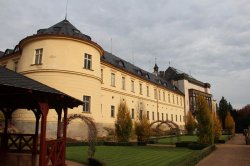Chateau Zbiroh
Zbiroh, a chateau where the general public has been banned for many years, stands in the beautiful surroundings of the deep Křivoklát forests near Brdy. This is not just an "ordinary" lock. This one boasts several "best" ...
Information for visitors
Interesting facts Chateau Zbiroh
It is referred to as the castle of the three emperors, because it was owned for some time in the history of the Czech lands by Charles IV, Sigismund of Luxembourg and Rudolf II.
THE BEST Zbiroh chateau:
The original castle, which stood here, was built on the hardest jasper rock
The castle well is 163 m deep and is the deepest in Europe
The massive tower is the first independent castle voice in Bohemia. It has walls 4 m thick and reaches a height of 20 m
Zbiroh is the first Manx castle in Bohemia
It was the most secret spy workplace in Czechoslovakia
The castle is surrounded by the largest landscape park in the Rokycany region
Painter Alfons Mucha created his largest canvases here
Originally, a castle was founded in Zbiroh from the 13th century, founded by the lords of Zbiroh, and after them a number of owners changed. They were, for example, the Rožmberks, Kolowrats, Šternberks or Lobkovics, under whose ownership the castle was rebuilt into a Renaissance chateau. After the Lobkovic castle was confiscated, it became the property of the emperor and served as a prison for political opponents.
During the Thirty Years' War, the chateau caught fire, so building modifications were necessary, which were then carried in the Baroque style, later also in the Classicist style. Another of the owners, Henry Strousberg, had neo-Renaissance alterations and originally wanted to build an industrial center from the Zbirož chateau, while he managed to devastate the surroundings of the chateau.
The last aristocratic owners of Zbiroh were the Colloredo-Mansfelds, under whose ownership the painter Alfons Mucha stayed at the chateau, who created his most famous work here, the Slavonic Epic.
During the Second World War, the castle housed the SS staff, and after 1945 there was an army for half a century. In 1989, the castle was returned in restitution to the original owners of the Colloredo-Mansfeld family. After that, the chateau was reconstructed and opened to the public in 2005.
Author: Andrea Štyndlová



















